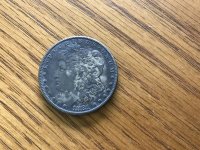P.ALLEN
Hero Member
- Jun 8, 2017
- 642
- 811
- Detector(s) used
- AT Pro, Tesoro Compadre, Ace 250, CMS magnetics, Garrett pinpointer, Fiskars trenching spade.
- Primary Interest:
- All Treasure Hunting
So, I have some timber that I salvaged from an old bridge (it floated free while I was fanning out debris around it(tons of coins in the cracks)) so I took it home to make some walking canes from. I didn't want it to go to waste. It's sitting in a kiddie pool of fresh water in the backyard (I hosed it down good then fully submerged it). Does anyone know about preservation of cut timber like this? I know if it dries out right now it will just get brittle and fall apart, but I want to use it. HALP! Merci beaucoup.
EDIT: Important info; it's been submerged for around a hundred years +/- 10 years I reckon.
EDIT: Important info; it's been submerged for around a hundred years +/- 10 years I reckon.




